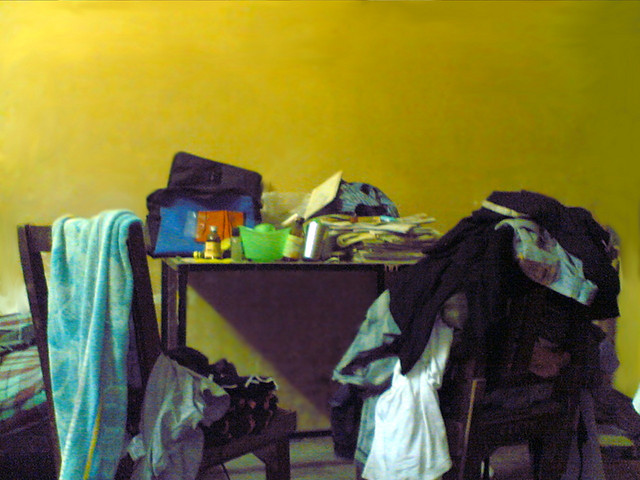We’re wrapping up our month devoted to the concept of helping you achieve your New Year’s goal of going clutter-free (or at least de-cluttering a bit) by talking about a challenge that often gets overlooked in the talk of clutter. The partners or other loved ones of clutterers. You may be surprised how many couples or partnerships we know where one person adores building up collections of “stuff” and the other person adores clear spaces and hates junk. So how do you reach an agreement on how to happily live together in a shared space with such divergent lifestyle preferences? We have some tips – and they’re actually proven tips since this situation applies to at least two households of people on the Postconsumers content team!
First, You Need to Come to an Agreement on How Much Clutter You Can Agree On
Here is the first thing that you need to understand: neither of you are ever going to get to completely have your way when it comes to how much or how little “stuff” is in your space. After all, compromise is the key to a good relationship and you both have varying viewpoints. The most important thing to remember here is the nature of compromise and how important it is. You need to allow the clutter lover to have some stuff and some areas of clutter (though you are also welcome to point him or her to our clutter reduction library and help them along in their journey). Likewise, you have to allow your open-space lover to have clear, clean areas in the home. It’s actually quite important to their mental state. So, the question is, how much is too much of either thing? As you’re having this conversation, keep the other tools mentioned in this article in mind.
Designate Spaces for Clutter and Clear
One of the easiest ways to manage a person who loves clutter and a person who doesn’t is to designate spaces for each kind of lifestyle. Yes, it’s true that your space is ultimately a shared space. But if how you address and store stuff is much different, then this really will be the best option for you. In an ideal world, you can do this by room. Remember that – in truth – a less cluttered area is better for your mental health and probably honestly more important to the mindset of the person who dislikes clutter. So prioritize rooms where you (and in particular your open-space lover) spend a lot of time as clutter-free zones. This is often going to coincide with the rooms you entertain in the most so it will all work out. Living rooms, bedrooms and bathrooms are often the best places to designate as clutter free. Family dens, libraries, kitchens and craft rooms are often the best spaces to allow clutter. As for entry ways and dining rooms, you’ll need to work that out! It is possible to do this on a smaller scale, with areas in each room designated for clutter or non-clutter. However, in our experience, you’re actually just going to probably find yourself still frustrated with the outcome if you do that.
Give Your Clutterer Space for Piles
We’ve found that a common habit of people who love clutter is that they tend to make tiny piles of clutter all through your home or space. That’s no good for your mindset if you are a person who despises clutter! Chances are also good that they are not breaking this habit any time soon. Our best idea for a solution is to give them areas to assemble their piles that are out of the public sight. Our solution? Decorative bowls where they can dump all of their clutter items. Another option is drawers, but then you are less likely to periodically clear out the drawer and get rid of the clutter. And you don’t need to jump on the consumer machine bandwagon to stock your home or space with decorative bowls. You can find plenty of wonderful ones at yard sales, thrift stores and consignment shops.
Don’t Get Frustrated. Talk It Out.
This is frankly probably pretty good relationship advice in any situation – but it’s particularly true if you live with somebody who loves clutter because the reality is that their stuff will encroach on your space and create messes no matter how much you try to avoid it. And it will be frustrating and it will make you angry. But it’s not going to get you anywhere to keep getting angry. Just keep talking the clutter issues through and reinforcing the chosen behavior for where clutter should go in the home. It will take time – likely lots of time, but eventually you’ll get there.
Schedule Regular De-Cluttering Days
How co-habitators handle their chore lists can vary widely. Some people like a list. Some people like a more casual approach. But if you’re an open-space lover living with a clutter-lover, the schedule or list is your friend because you can at least be sure that clutter and junk is getting cleared periodically. How detailed you get with this is entirely up to you – but we promise you that if you have set dates for when areas of clutter or stuff need to get cleaned out, you’ll find that it gets done more often.
Do Not Clear Their Clutter For Them
We assure you that you will often feel tempted to go through the house and get rid of all of your partner’s clutter and junk for them. Don’t do it! Not only does it not solve the problem long term, but your partner’s need for “stuff” and clutter is just as tied to their mental state as your need for open-spaces is to yours. When you clear their clutter for them it’s actually quite disrespectful of their mental and emotional needs and it’s going to cause more friction than taking a longer time to solve the problem together.
Remember, Neither of You are Perfect
Both of you have a relationship to “stuff” that stems from a mental or emotional place, and altering that is challenging. No matter how many guidelines and conversations you have, remember that neither of you are perfect. You both will likely fail at points with either controlling clutter or managing your frustration about clutter. Give each other space to be imperfect and remember that relationships and co-habitating are never, ever easy!
Did we miss a thought on how to live with somebody who loves stuff and clutter that you want to share with us? If so, just tell us about it on one of the social media channels below.
Facebook | Twitter | Instagram | Tumblr | Pinterest | Google+





